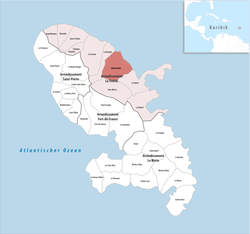Sainte-Marie, Martinique
 From Wikipedia - Reading time: 7 min
From Wikipedia - Reading time: 7 min
Sainte-Marie | |
|---|---|
 A view of Sainte-Marie from the islet | |
 Location of the commune (in red) within Martinique | |
| Coordinates: 14°44′N 61°01′W / 14.73°N 61.02°W | |
| Country | France |
| Overseas region and department | Martinique |
| Arrondissement | La Trinité |
| Intercommunality | CA Pays Nord Martinique |
| Government | |
| • Mayor (2020–2026) | Bruno Nestor Azérot[1] |
Area 1 | 44.55 km2 (17.20 sq mi) |
| Population (2021)[2] | 14,650 |
| • Density | 330/km2 (850/sq mi) |
| Time zone | UTC−04:00 (AST) |
| INSEE/Postal code | 97228 /97230 |
| Elevation | 0–574 m (0–1,883 ft) |
| 1 French Land Register data, which excludes lakes, ponds, glaciers > 1 km2 (0.386 sq mi or 247 acres) and river estuaries. | |
Sainte-Marie (French pronunciation: [sɛ̃t maʁi] ; Martinican Creole: Sentmawi) is a town and the fifth-largest commune in the French overseas department of Martinique. It is located on the northeast (Atlantic Ocean) side of the island of Martinique.
Geography
[edit]Climate
[edit]Sainte-Marie has a tropical rainforest climate (Köppen climate classification Af). The average annual temperature in Sainte-Marie is 26.5 °C (79.7 °F). The average annual rainfall is 2,781.3 mm (109.50 in) with November as the wettest month. The temperatures are highest on average in August, at around 27.5 °C (81.5 °F), and lowest in January, at around 25.1 °C (77.2 °F). The highest temperature ever recorded in Sainte-Marie was 35.0 °C (95.0 °F) on 23 September 2005; the coldest temperature ever recorded was 16.5 °C (61.7 °F) on 8 March 1987.
| Climate data for Sainte-Marie (1991−2020 normals, extremes 1979−2009) | |||||||||||||
|---|---|---|---|---|---|---|---|---|---|---|---|---|---|
| Month | Jan | Feb | Mar | Apr | May | Jun | Jul | Aug | Sep | Oct | Nov | Dec | Year |
| Record high °C (°F) | 31.5 (88.7) |
33.0 (91.4) |
32.0 (89.6) |
34.5 (94.1) |
34.5 (94.1) |
34.0 (93.2) |
34.0 (93.2) |
35.0 (95.0) |
35.0 (95.0) |
34.5 (94.1) |
34.0 (93.2) |
32.0 (89.6) |
35.0 (95.0) |
| Mean daily maximum °C (°F) | 28.9 (84.0) |
29.0 (84.2) |
29.5 (85.1) |
30.3 (86.5) |
31.0 (87.8) |
30.9 (87.6) |
31.1 (88.0) |
31.6 (88.9) |
31.7 (89.1) |
31.4 (88.5) |
30.4 (86.7) |
29.6 (85.3) |
30.4 (86.7) |
| Daily mean °C (°F) | 25.1 (77.2) |
25.1 (77.2) |
25.4 (77.7) |
26.2 (79.2) |
27.0 (80.6) |
27.3 (81.1) |
27.3 (81.1) |
27.5 (81.5) |
27.5 (81.5) |
27.2 (81.0) |
26.4 (79.5) |
25.7 (78.3) |
26.5 (79.7) |
| Mean daily minimum °C (°F) | 21.3 (70.3) |
21.2 (70.2) |
21.4 (70.5) |
22.1 (71.8) |
22.9 (73.2) |
23.7 (74.7) |
23.6 (74.5) |
23.4 (74.1) |
23.2 (73.8) |
23.1 (73.6) |
22.5 (72.5) |
21.8 (71.2) |
25.5 (77.9) |
| Record low °C (°F) | 18.0 (64.4) |
16.5 (61.7) |
16.5 (61.7) |
18.0 (64.4) |
19.5 (67.1) |
20.0 (68.0) |
19.0 (66.2) |
18.0 (64.4) |
19.0 (66.2) |
19.0 (66.2) |
17.0 (62.6) |
17.5 (63.5) |
16.5 (61.7) |
| Average precipitation mm (inches) | 167.4 (6.59) |
103.2 (4.06) |
125.9 (4.96) |
213.6 (8.41) |
215.1 (8.47) |
196.2 (7.72) |
248.4 (9.78) |
275.0 (10.83) |
283.5 (11.16) |
346.9 (13.66) |
374.9 (14.76) |
231.2 (9.10) |
2,781.3 (109.50) |
| Average precipitation days (≥ 1.0 mm) | 21.6 | 16.6 | 17.0 | 16.3 | 17.4 | 19.4 | 23.2 | 23.0 | 20.7 | 22.7 | 23.6 | 21.2 | 242.7 |
| Source: Météo-France[3] | |||||||||||||
Population
[edit]Graphs are unavailable due to technical issues. There is more info on Phabricator and on MediaWiki.org. |
| Year | Pop. | ±% p.a. |
|---|---|---|
| 1967 | 19,515 | — |
| 1974 | 20,128 | +0.44% |
| 1982 | 18,526 | −1.03% |
| 1990 | 19,682 | +0.76% |
| 1999 | 20,098 | +0.23% |
| 2007 | 19,249 | −0.54% |
| 2012 | 17,342 | −2.06% |
| 2017 | 15,932 | −1.68% |
| Source: INSEE[4] | ||
See also
[edit]References
[edit]- ^ "Répertoire national des élus: les maires". data.gouv.fr, Plateforme ouverte des données publiques françaises (in French). 2 December 2020.
- ^ "Populations légales 2021" (in French). The National Institute of Statistics and Economic Studies. 28 December 2023.
- ^ "Fiche Climatologique Statistiques 1991-2020 et records" (PDF) (in French). Météo-France. Retrieved September 7, 2022.
- ^ Population en historique depuis 1968, INSEE
External links
[edit]- Official website (in French)
- Base Mérimée: Search for heritage in the commune, Ministère français de la Culture. (in French)

 KSF
KSF